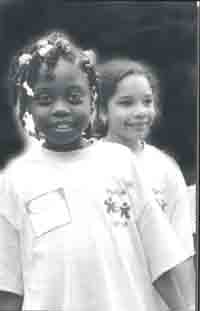As Anita Remignanti states, “Children are potentially the light of the world and they are our hope as future peace-keepers of the world,” 1. However, the violent aspects of popular culture and society today often downplay childish creativity and innocence in favor of gender stereotypes, war games, and isolating television shows and movies. In addition, children are urged more and more to compete with one another even in their earliest years of school, instead of learning the integrative value of cooperation. Everyday, our youth are victims of violence, witnesses to violence, and sometimes even perpetrators. According to statistics, 14 children each day are killed with a handgun; 315 young people are arrested daily for committing a violent crime; and a typical child witnesses an overwhelming 10,000 acts of violence on television before she or he enters school2. It is crucial, therefore, to remember that violence is a learned behavior, not an inherent one. If we want future generations to have peace of mind and healthy relationships instead of material success at the expense of all else, innovative and constructive education programs can create an alternative to the current system. One such program that works to harness children’s natural cooperative and creative tendencies is called “Peace Games.”
According to the program’s website, “Peace Games imagines a world where every child has the skills, knowledge, supportive relationships, and opportunities to prevent violence and build safer communities. A world where individuals and institutions believe in the power of young people and that violence – in all of its forms – can be prevented. Peace Games believes that this goal is best achieved by building the capacity of schools and community groups to implement holistic, peace and justice education programs.3” This program builds upon the idea that children do not have to be society’s victims of violence; rather, they have a unique capability to act as agents in creating peace. The goals of Peace Games are to empower children with the skills, knowledge, relationships, and opportunities to be peacemakers; to engage all community members (students, families, teachers, volunteers, organizations, and businesses) to support children as peacemakers; to inspire a new generation of educators and activists; and lastly, to demonstrate that youth can be influential peacemakers rather than the passive victims of a violent culture.
Guided by a unique K-8 curriculum, the children in Peace Games focus on four different areas in their education as peacemakers: knowledge, skills, relationships, and opportunities. In cultivating their knowledge, the children learn to be problem-solvers and are instructed in all of the state academic frameworks, especially language arts, literacy, social studies, health, and fine arts—areas that can be neglected in schools that focus on math and science. While they are learning practical knowledge, the children also learn to communicate effectively with one another and solve conflicts in a cooperative, nonviolent manner. This demonstrates a main principle of conflict transformation: that instead of being an obstacle to peaceful progress, conflict can be viewed as an opportunity to improve relationships and promote mutual growth. In working through their conflicts together, the children in Peace Games partner schools are also learning to use nonviolence as an active force for change. The Peace Games program fosters interpersonal relationships between teachers and students within the school and relationships between the school and the community through community service and social action. Finally, students are given the opportunity to demonstrate their skills and knowledge and build upon their relationships through individual Peacemaker Projects, which can involve student-to-student mentorship, civic responsibility, and the improvement of the school and the community.
Dr. Francelia Butler created Peace Games in 1992 as an opportunity for children to share games, laughter, communication, friendship, and conflict resolution—“the building blocks for a peaceful future”4—while receiving an education. Since its foundation, this non-profit organization has worked with over 20,000 elementary and middle school students, recruited and trained over 2,100 college and community volunteers, and worked with almost 9,000 family members to encourage peacebuilding at home. Peace Games has made an impact across the country, with seven partner schools in Boston, three in Los Angeles, one in Chicago, three in New York City, and two in Fairbanks, Arkansas.
So far, all evidence indicates that this innovative program is meeting its goals of producing knowledgeable peacemakers. According to data from a 2004 evaluation of Peace Games schools in Boston and Los Angeles, over 90% of students reported that Peace Games had helped improve their academics, empathy, and peacemaking skills (communication, cooperation, conflict resolution and engagement), become positively engaged in service learning projects. In addition 78% of students reported that they are more likely to walk away from a fight without thinking of themselves as cowards, and 96% of students reported that they now include peers in their recess and classroom groups and know how to work well together on cooperative teams. Finally, 60% of teachers noted reduced levels of student fights and arguments.
The development of Peace Games is an important step in the creation of a constructive culture based on the principles of cooperation and creative conflict resolution. In the years to come, this program will continue to serve as a progressive and dynamic alternative to standard education, and will hopefully serve as one possible model for other programs across the country. After all, in building a better world, it is the littlest ones who can make the biggest difference.
For more information, visit the Peace Games website at www.peacegames.org
1 Remignanti, Anita. “Peace and Child Rearing”. Women for International Peace and Arbitration. www.wipa.org/peace_and_cr.htm . 10/15/06.
4 http://www.peacegames.org/About_history.shtml

